Related Research Articles

The bar-shouldered dove is native to Australia and southern New Guinea. It is protected under the National Parks and Wildlife Act 1974. It is a medium-sized pigeon varying in size from 26–30 cm (10–12 in). Its voice is a distinctive and melodious "cook-a-wook" or "coolicoo".
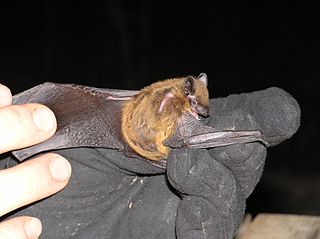
Nycticeius is a small genus of bats in the vesper bat family, Vespertilionidae, and the only member of the tribe Nycticeiini. It contains three species, the evening bat, the Cuban evening bat and Nycticeius aenobarbus. Some authorities include several other Old World species in Nycticeius, but recent genetic work shows that is a completely New World genus. Nycticeius is of Greek and Latin origin, meaning "belonging to the night".

The evening bat is a species of bat in the vesper bat family that is native to North America. Hunting at night, they eat beetles, moths, and other flying insects.
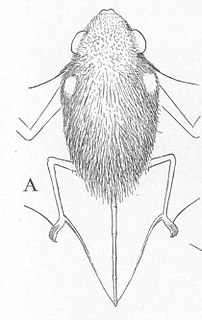
Allen's spotted bat is a species of vesper bat in the family Vespertilionidae found in the following countries: the Central African Republic, the Democratic Republic of the Congo, Kenya, and Uganda. It is found in subtropical or tropical moist lowland forests.

The yellow-shouldered grosbeak is a species of bird in the tanager family Thraupidae. It is the only member of its genus Parkerthraustes. It is found in Bolivia, Brazil, Colombia, Ecuador, and Peru. Its natural habitat is subtropical or tropical moist lowland forests.

Humerana humeralis is a species of frog in the family Ranidae. It is found in Bangladesh, India, Myanmar, Nepal, and possibly Bhutan. Its natural habitats are subtropical or tropical moist lowland forests and rivers. It is threatened by habitat loss.

The tawny-shouldered blackbird is a species of bird in the family Icteridae. It is found in Cuba and Hispaniola. It is a vagrant in the United States.

The black-chested sparrow is a species of bird in the family Passerellidae that is endemic to Mexico. Its natural habitats are subtropical or tropical dry shrubland and subtropical or tropical high-altitude shrubland.
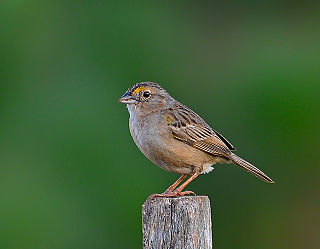
The grassland sparrow is a species of bird in the family Passerellidae. It is found in Argentina, Bolivia, Brazil, Colombia, French Guiana, Guyana, Paraguay, Peru, Suriname, Uruguay, and Venezuela. Its natural habitats are dry savannah, subtropical or tropical seasonally wet or flooded lowland grassland, and pastureland.

The white-throated robin-chat or white-throated robin is a species of bird in the family Muscicapidae. It is endemic to Botswana, Mozambique, South Africa, Swaziland, and Zimbabwe. Its natural habitats are dry savannah and subtropical or tropical dry shrubland.

Pangasius is a genus of medium-large to very large shark catfishes native to fresh water in South and Southeast Asia. The term "pangasius" is sometimes used to specifically refer to the commercially important basa fish, P. bocourti.

The chestnut-shouldered antwren is an insectorivous bird in the antbird family Thamnophilidae. It is found in far northwestern Bolivia, Peru, Ecuador and western Brazil. Its natural habitat is subtropical or tropical moist lowland forests.
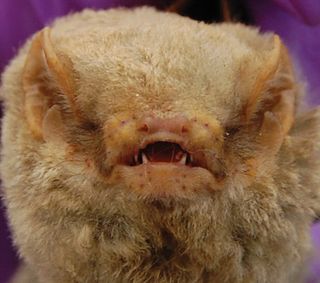
Glauconycteris is a genus of vespertilionid bats found in Africa.
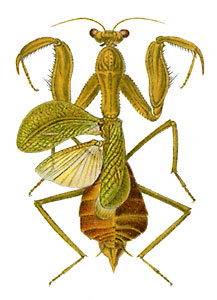
Cilnia humeralis, common name wide-armed mantis, is an aggressive and very cannibalistic species of praying mantis from Africa.
The Cuban evening bat is a species of bat in the vesper bat family, Vespertilionidae, that is endemic to western Cuba. It is a small bat, even smaller than cogener Nycticeius humeralis. It is insectivorous, but otherwise little is known about its behavior and diet.

The northern fiscal is a member of the shrike family found through most of Sub-Saharan Africa. It used to be grouped with the southern fiscal. Together they were called the common fiscal.
Megalofrea humeralis is a species of beetle in the family Cerambycidae. It was described by Vollehoven in 1869. It is known from Madagascar.
Piampatara ocreata is a species of beetle in the family Cerambycidae. It was described by Henry Walter Bates in 1885. It is known from Panama and Costa Rica.
Piampatara proseni is a species of beetle in the family Cerambycidae. It was described by Martins and Galileo in 1997. It is known from Bolivia.
Piampatara ubirajarai is a species of beetle in the family Cerambycidae. It was described by Lane in 1966. It is known from Brazil.
References
- ↑ BioLib.cz - Piampatara humeralis. Retrieved on 8 September 2014.